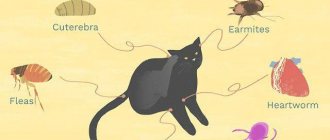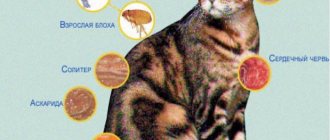Worms
(scientific name
helminths
) are worms that live inside humans. Worms are parasites, that is, organisms whose life activity is based on the exploitation of the host organism.
Helminths (worms) are the most common human parasites. According to research, every 4th person in the world is infected with worms. 70 species of worms have been registered in Russia. They all belong to three classes: roundworms, flatworms and flukes. The most common roundworms are roundworms, mainly pinworms, roundworms and whipworms.
There are also intestinal and extraintestinal helminths. Intestinal are those that live in the lumen of the human intestine, and extraintestinal (or tissue) are those living in muscle tissue or organs. Worms can affect the brain, lungs, liver, and lymphatic vessels.
Several types of helminths can parasitize one person at once, and this is a fairly common situation.
Infection of a person with worms is called helminthic infestation
.
helminthiasis
is also used .
Causes of helminthiasis
How does worm infection occur?
Adults inside humans lay a huge number of eggs (hundreds and thousands per day). Worm eggs are excreted from the human body along with feces. In order for a new host to become infected, it is necessary for the helminth eggs to enter his intestines. In most cases, this occurs along with food intake, for example, when eating with unwashed hands or when eating unwashed vegetables and fruits. Some types of helminthic infestations are geohelminthiases. In this case, the eggs of the parasite must first mature by being in the soil for some time (such as roundworms). Other types of worms are used for the maturation of intermediate “hosts” - animals. These are tapeworms - the most famous of the flat parasitic worms - bovine and pork. Their larvae mature in the muscles of animals and enter the human body along with meat that has not undergone proper heat treatment, and already inside a person they turn into an adult.
The opposite situation is also possible, when the human body is used by the helminth as an incubator for the larvae. The final host of such parasites is a predator. The predator is expected to catch the prey and eat the meat infected with the larvae. In this regard, a person is a dead end - a larva that gets into it will no longer turn into an adult, but the larvae
predator worms can cause us a lot of harm. In the human environment, two typical predatory animals are a dog and a cat. They can become a source of infection. The eggs of worms from these animals enter the human intestine, where they hatch into larvae, which can then migrate throughout the body. The liver is most often affected. To prevent infection from pets, you should not kiss them, and a dog that can become infected with helminths while running along the street must be subjected to regular treatment for worms.
Also, worm eggs can enter our body through inhalation of dust or with a sip of water when swimming in a pond. Flies carry worm eggs.
DIPILIDIOSIS
Dipylidium caninum - pumpkin, cucumber or dog tapeworm. This is a white or slightly yellowish cestode, 20-50 cm long, 3 mm wide. The scolex is equipped with four oval suckers and a club-shaped retractable proboscis with 4-8 transverse rows of hooks.
Routes of infection
- Ingestion of infected fleas, lice eaters.
Life cycle
Mature segments, breaking away from the strobila, actively emerge onto the perianal folds, where they are destroyed, and the eggs are dispersed into the external environment and onto the animal’s fur. Flea larvae
and
lice eaters
eat oncospheres (eggs), but no changes occur in them.
The oncosphere begins to develop into a cysticercoid in the pupa of an ectoparasite insect. An animal becomes infected by licking and gnawing fleas
,
lice eaters
, and swallowing them. They are digested, and the released cysticercoids attach to the wall of the small intestine, developing into adults.
Definitive owner
– dogs, cats, foxes, wolves, jackals and other carnivores.
Intermediate host
– ectoparasite insects (fleas, lice eaters, etc.)
Humans are the facultative host due to accidental infestation (flea ingestion).
Symptoms
Symptoms are nonspecific; more often the disease occurs latently. The general condition is depressed, motor activity and appetite decrease, the animal loses weight, and the quality of the coat deteriorates. With significant infestation, manifestations of enteritis (diarrhea, constipation, bloating) are possible due to the irritating effect of the tapeworm's suckers and hooks on the intestinal wall. Motile proglottids can be found in feces. With massive invasion, intestinal obstruction can form.
Worms in children
Children become infected with worms more often than adults. Small children tend to put everything in their mouth. While walking, children play on the ground and in the sandbox. They can hug and kiss strangers and stray animals. They don't care about dirty hands.
Therefore, it is so important to try to instill hygiene skills in children as early as possible. Young children should be supervised during walks, always having water and disinfectants ready to wash their hands and wipe their faces in time. And at the first signs of helminthic infestation, you should consult a doctor.
In Moscow, the most frequently detected helminth infections are enterobiasis and ascariasis.
Probability of human infection
New medications and therapeutic techniques are a 100% guarantee of success with timely treatment and the correct approach to diagnosis. The prognosis is favorable. In most cases, fairly reliable protection of a pet from infection with cestodes is the fight against blood-sucking ectoparasites.
Is there a chance of human infection? Yes, there are such cases, and this applies not only to echinococci and alveococci. Doctors have documented situations of human infection even with the cucumber tapeworm, which is relatively “safe” for people. After all, even inveterate neat freaks have a chance to swallow an infected flea. What can we say about small children who put any object of interest into their mouths! Thus, when caring for your sick pet, you need to strictly observe at least basic hygiene principles! If you have elderly people and/or small children at home, it is better to treat your pet on an outpatient basis. In cases where this is not possible, the animal must be completely isolated for the entire period of treatment.
By the way, getting a little off topic. Many parents assume that pinworms in their offspring are the result of contact with cats. Is this really true? No, this is a common misconception. Pinworms are specific to humans ; they do not parasitize cats at all. However, this does not in any way eliminate the need to constantly remind the younger generation of the importance of regular hand washing. This simple measure can save you from many problems.
Enterobiasis – helminthiasis caused by pinworms
Pinworms are detected more often than other helminths (in 90% of cases of detection of worm infection).
Pinworms are grayish-white roundworms ranging from 2 to 12 mm in length. They parasitize the intestines. Females descend along the rectum, emerge from the anus and lay eggs in its circumference, after which they die. In this case, the patient feels severe itching in the anus. When scratching, pinworm eggs get on the skin of the hands and under the nails. Thus, if hygiene rules are not followed, constant self-infection is possible.
Pinworms have a short lifespan - 3-4 weeks. Theoretically, in order to be cured, hygiene procedures are enough - daily washing, keeping your hands clean, regularly changing your underwear and bed linen. And in a month the pinworms should disappear. However, since they primarily infect children, it is often impossible to ensure the necessary level of hygiene. Therefore, if you suspect enterobiasis, you should consult a doctor.
The main symptom of enterobiasis is itching in the anal area.
More about enterobiasis>>>
Ascariasis - helminthiasis caused by roundworms
Ascariasis is diagnosed in 70% of cases of helminth infection.
Ascaris is a round worm, the length of which reaches 25 cm in males and 40 cm in females. Ascaris eggs must mature in the ground. Ripe eggs enter the human body when eaten with dirty hands or from unwashed vegetables and fruits. A larva hatches from an egg in the human intestine, but, unlike an adult, it requires air. Therefore, the larva, which at this moment has a microscopic size, penetrates the blood vessels and migrates throughout the body, reaching the lungs. In the lungs, the larvae grow and mature, moving through the alveoli into the bronchi, and from the bronchi into the trachea. The human body reacts to the helminth by coughing (this is a specific symptom of ascariasis). The larvae are expectorated along with sputum and are accidentally ingested by humans. This allows the already developed larva to enter the intestine again, where the adult continues to exist. The entire migration process takes about 2 weeks.
Roundworms can live in the human body for up to a year, in some cases longer. During this period, the waste products of the roundworm poison the body of the “host”, causing disturbances in the functioning of the digestive, nervous and reproductive systems.
Photo gallery
Photo 1. Anti-worm medication
Photo 2. One of the ways of infection with helminths
Photo 3. Types of helminths
Symptoms of helminthiases
The body tries to resist the penetration of worms. The first consequences of helminth infestation are precisely related to the body’s immune response to the ingress of helminth eggs and larvae. This acute stage lasts (depending on the type of parasite) from several weeks to several months. An allergic reaction can be expressed in the form of a rash, swelling, swollen lymph nodes, cough, etc.
If all the body’s protective barriers are broken, then helminthiasis enters the chronic stage.
The larva develops into an adult. In the case of single parasites, a person may not notice their presence, but if there are many helminths, then the consequences of their presence inside the body significantly affect health.
Worms damage tissues by attaching to them using their fixation organs (hooks, spines, etc.), as a result of which inflammation can develop in this place.
Worms create a comfortable environment for themselves. In particular, they cause suppression of the immune system so that the body's defense system no longer reacts to their presence. Reduced immunity causes a person to become susceptible to various infectious diseases.
The presence of worms in the human intestines disrupts metabolism, as the worms absorb nutrients (proteins, minerals, vitamins, carbohydrates). Some varieties of worms secrete substances that neutralize the digestive enzymes of the host. The waste products of worms cause changes in the intestinal microflora, promoting the development of pathogenic microorganisms.
Many types of worms are hemophages, that is, they feed on the host’s blood, contributing to the development of anemia and vitamin deficiency (worms absorb the much-needed vitamin B12).
If the parasite lives not in the intestines, but in the tissues of some organ, then its growth causes compression and deformation of the tissues, which can lead to disruption of the functions of this organ (brain, liver, eyeball).
Suspicion of helminthiasis, first of all, causes disruption of the digestive system and neurological disorders.
Gastrointestinal manifestations of helminthic infestation
The consequences of the presence of worms in the body are not specific and can be mistaken for symptoms of various diseases. A person may complain of occasional pain in the abdominal area of unclear localization, flatulence, or a feeling of fullness in the abdomen. Appetite may increase or be completely absent. Bowel disturbances (constipation or diarrhea) may occur.
Neurological manifestations of helminthic infestation
Helminthic infestation is often the cause of neuropsychiatric disorders - this is the result of the presence in the blood of toxins produced by helminths. The patient may feel general weakness, emotional instability, fatigue, and loss of concentration may be observed.
Methods for diagnosing helminthiasis
Since the symptoms of helminthiasis coincide with the signs of many other diseases, before prescribing treatment, it is necessary to make sure that worms are actually present in the body. For this purpose, various laboratory diagnostic methods are used.
Analysis of stool for worm eggs
If a helminthic infestation is suspected, the first step is to perform a stool test for worm eggs. To be more confident in the absence of worms, it is recommended to do such an analysis several times (a negative result in the case of a single analysis does not guarantee that there are no worms). However, enterobiasis cannot be detected using stool analysis.
More information about the diagnostic method
Scraping for enterobiasis
Scraping for enterobiasis allows you to identify pinworm infection.
Serological blood test
In difficult situations, additional tests are possible, in particular, a serological blood test for the presence of antigens and antibodies to a particular type of parasite.
More information about the diagnostic method
Sign up for diagnostics To accurately diagnose the disease, make an appointment with specialists from the Family Doctor network.
Methods for treating helminthiases
Despite the fact that helminthiasis is a common occurrence, it cannot be treated as something normal.
Worm infestation is a serious problem for the body, in some cases it can even lead to death. Worms cannot be tolerated. Infection with worms must be prevented, and if it occurs, the worms must be removed. To treat helminthiases, courses of special medications are prescribed.
If you suspect a worm infection, you should consult a therapist, and if you are talking about a child, a pediatrician or family doctor. In some cases, the doctor may recommend that the whole family take anthelmintic medications.
Pediatricians, family doctors and therapists at Family Doctor have extensive experience in identifying and treating various helminthiases. It is worth remembering that getting rid of parasites is a serious increase in our health!
Deworming
The procedure for removing worms from the body is called deworming
.
Along with anthelmintic drugs, the course of treatment usually includes drugs that help remove and bind toxic substances produced by worms, as well as antiallergic drugs.
Make an appointment Do not self-medicate. Contact our specialists who will correctly diagnose and prescribe treatment.
Rate how useful the material was
thank you for rating
Prevention
Prevention of worms in cats is quite simple. The best preventative measures are considered to be special medications and drops that are applied to the withers, which allows you not to worry about possible infection of your pet for a period of 3 to 6 months. In addition, the same medications can be used here as for treatment. Only the frequency of administration and dosage will be different.
To prevent the appearance of helminths, you need to understand the importance of providing your pet with decent living conditions. It is necessary to disinfect the trays weekly and wash the cat's dishes after each feeding. By the way, it would not be superfluous to remind you that you should not leave uneaten food in a bowl for the whole day. This can not only lead to infection of the pet, but also to ordinary poisoning.











